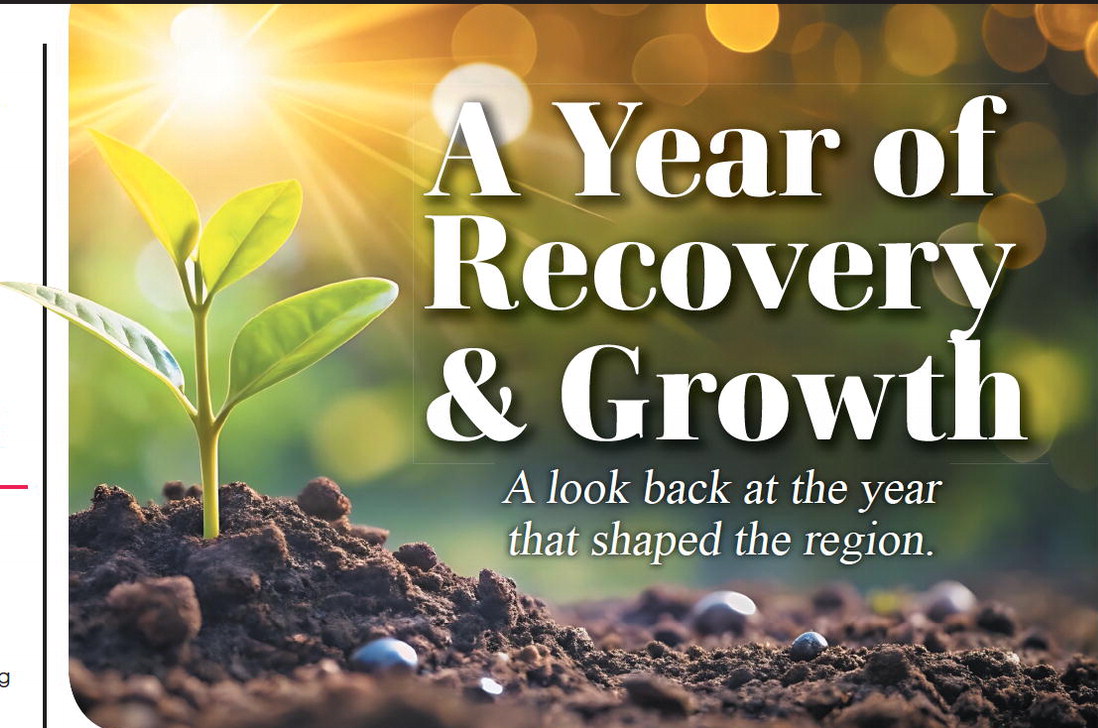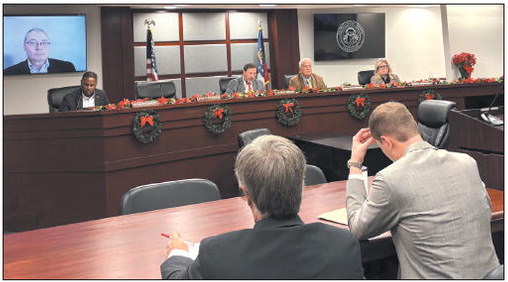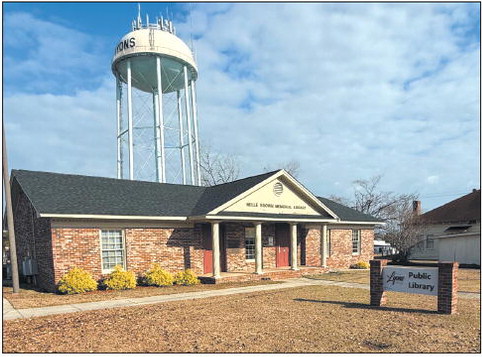State Chamber President Predicts Georgia’s Future


mrandolphadvance@gmail.com
The Georgia Chamber of Commerce President and CEO Chris Clark gave local business owners and professionals a glimpse into what he believes Georgia will look like in 2050 during an event at the First Baptist Church of Lyons on September 4. Clark spoke in Lyons as a part of the Georgia 2050 Tour, where he traveled the state to share data that the State Chamber of Commerce has analyzed to help determine what continued from page
Georgia will look like in 25 years. He used this information to offer advice on how individuals should prepare for these changes to help improve the workforce and adapt with the times.
“The work in this presentation really started around 2 years ago when we started talking to business leaders and government leaders – surveying them [and] polling them about the challenges they face and about what Georgia is going to look like in the future,” Clark explained. “What we found when we were doing that research and survey is that business and government leaders weren’t looking 2 years and 3 years in the future – they were thinking 15, 20, 25 years in the future.”
He said that when he and his team began pondering why these leaders would be looking so far ahead, they realized the large investments that businesses, schools, and roads were 25100 year investments. He told the audience to think about the children in their lives that were college age and younger, and then to add 25 years onto their current age. “That’s when we’re looking at,” he told the audience.“ I want to make sure that Georgia is doing what it needs to do – that this community is doing what it needs to do – to take care of my kid. The truth is, someone stood in the room 25 years ago and made tough decisions, and that’s why we’re here,” Clark remarked.
He shared information on the projected population growth and changes to the population demographics.
Clark said that the projected population growth for the state is an increase of 2.5 million people, making the total population projected for the state to be around 13.5 million. “That’s a much smaller number than it should be. When we were looking at this projection around 3 years ago, we were projecting a 3.5 million [increase],” he commented, as he explained that population growth has slowed down because of the decreased birth rate in the state.
Yet, even with this slowed population growth, the growth rate percentage in rural Georgia is projected to equal the growth rate percentage in Atlanta. “Our younger men and women want to return back to a small town. [Greater Vidalia Chamber President] Michele [ Johnson] is about to recruit companies to come here so they can do that,” he added.
He commented that though he knew some people in a small town don’t like to think about growth, he feels it’s necessary, because if you’re not growing, you are staying still and “withering away.”
Clark informed the audience that the city of Vidalia’s population growth is only expected to be around 3%, which he said is a manageable and good amount, as 5% population growth should be the goal.
He also addressed the shift in demographics in the workforce and the community, as the Silent Generation and Baby Boomers will decrease in the workforce and Millennials, Gen Z, and Gen Alpha will take over.
“We are about to go through a major generational change in Georgia,” Clark emphasized. “Baby boomers have been the base of Georgia’s population and workforce for the last 30 years. 100,000 Baby Boomers retire every day in America. If every Baby Boomer takes retirement by 2030, there will be 12 million vacant jobs. We do not have the pipeline to fill the skilled trades, the doctors, the nurses, and the teachers. From a community standpoint or a business standpoint, you need to find a way to keep boomers engaged in the workforce.”
He went on to share that millennials are projected to be 41% of Georgia’s workforce in 2050 – making them the biggest demographic in business. Gen Z is projected to fall closely behind, as they will make up 31% of the workforce.
“You’re not where you need to be as a community on bringing Gen Z home. That’s a critical part of the workforce that you need to work on every day,” Clark advised.
He continued, saying the Gen Alpha is projected to be the largest population in history, but these babies are being born all over the world rather than in the United States of America.
Ultimately, Clark emphasized the importance of studying the combinations of these employees to determine what the workforce will look like, as he asked the audience, “If we are going to have this multigenerational workforce here, what does that job makeup look like?”
He also broke down the workforce based on gender. “Women are in control today and they will be in control in 2050. Women make up 53% of the workforce in Georgia, by 2050, they should make up 56% of the workforce – but if you don’t fix childcare, you are leaving the biggest [and] most important part in their prime years out of the workforce,” he remarked.
Clark informed the audience that several population growths would occur in various demographics – the African American population is expected to grow 19.5%, the Hispanic population is expected to grow 50%, the white population is expected to grow 8%, and the “other” population (multiracial, etc.) is projected to grow 40%. He stated that these shifts in demographics will also cause a shift in the demographics of the workforce, and emphasized the importance of businesses changing their approach to recruiting employees. “If you’re still sending in people that look like me and [Greater Vidalia Chamber Public Policy Council Member] Mike [Hagan] to recruit workers that don’t look like us, you’ve got to rethink your strategy,” he remarked.
He shared that even amidst these changes, he expects the Georgia economy to continue to thrive. “There will be plenty of opportunities for small businesses, large businesses, and economic growth. Georgia should outpace the South with the exception of Texas,” Clark said.
He told the audience that two big issues are currently plaguing and are projected to continue to plague Georgia’s growth: energy and transportation issues.
“All that stuff that you’re buying right now, you’re plugging in. We need more power,” he stated. Clark explained that the recent expansions by power companies was a response to a need throughout the state for more power to power devices and electronics, as well as data centers that store photos and information. As for transportation, Clark emphasized that the current culture of online shopping is causing many issues for the transportation system, which will have to be continuously updated and maintained. “Since Covid, we have decided we can just order anything and have it delivered and it doesn’t cost anything. It is crippling our infrastructure every day to the point that we need $84 billion just to maintain our roads, bridges, and railroads over the next 25 years. Your local roads were not built for 15 box trucks to come down it every day to deliver,” he explained.
Clark went on to share that another shift in the economy of Georgia will be the addition of information and service industries and innovation industries into the economy, which previously was built on agricultural and industrial economies. He said that the goal of real Gross Domestic Product (GDP) growth in Georgia is around 2.3%, and that this goal may be achieved by business owners and employees focusing on the “prosperity pillars,” which include regional prosperity and healthy communities, talent and workforce preparedness, infrastructure and energy, innovation and entrepreneurship, and competitiveness and economic development.
He spoke about more facts about the shifting workforce, as he outlined the top 10 fields that would be in demand for employees. Currently, those top ten fields are healthcare, information technology, advanced manufacturing, engineering, skilled trades, logistics, biotech, data analysis, software developers, and energy. In 2050, the high demand fields will be healthcare, digital entrepreneurs, advanced manufacturing, robotic engineering, skilled trades, biotech, machine learning and artificial intelligence (AI), content creators and innovators, and CleanTech.
According to Clark, skills currently valued by employers are teamwork, social intelligence, critical thinking, adaptability and work ethic, and communication; yet, in 2050, the skills valued by employers are expected the be interpersonal and relational skills, social intelligence, critical thinking, adaptability and work ethic, interdisciplinary knowledge, ethical judgment, and creativity.
He explained that many of these skills could help to make sure that AI was not replacing your career. To be irreplaceable by AI, Clark said you should have social intelligence (the ability to respect and work with anyone), interdisciplinary skills (stackable skills, such as having 2 majors and minors in college), real world experience (through internships and teen jobs), adaptability and strong work ethic (being flexible and embracing change), critical thinking (managing complex issues), and creativity (innovation).
He gave several solutions to improving the workforce for 2050 that can begin in 2025, such as quality childcare, internships and apprenticeships, mentorships, entrepreneurial promotions, and skilled trades promotions.
At the end of his address, Clark invited Greater Vidalia Chamber President Michele Johnson and Toombs County Commission Chairman David Sikes on stage to discuss the impacts of these findings on the local area, and to outline any issues preventing growth in the county.

APPLYING THE INFORMATION – Greater Vidalia Chamber President Michele Johnson (right), Georgia Chamber of Commerce President and CEO Chris Clark (center), and Toombs County Commission Chairman David Sikes (left) discuss how the information found in the study affects the local community.Photo by Makaylee Randolph






